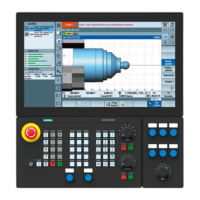File and Program Management
3.5 REDEF Changing the attributes of the NC language elements
Job planning
3-20 Programming Manual, 03/2006 Edition, 6FC5398-2BP10-1BA0
Optional parameters
Value (optional) Optional parameters for attributes INIPO, INIRE, INICF, PRLOC:
Subsequent start value(s)
forms:
Single value
value list
REP (w1)
SET(w1, w2, w3, ...)
(w1, w2, w3, ...)
n:
e.g. 5
e.g. (0, 1, 2, 3, 4, 5, 6, 7, 8, 9) for variable with 10
elements with
w1: the value list to be repeated
for variable with several elements, e.g. REP(12)
or
value list
required protection level parameter for attributes for APR or
APW
For GUD, the definition can contain a start value (DEF NCK INT
_MYGUD=5). If this start value is not stated (e.g. in DEF NCK
INT _MYINT), the start value can be defined subsequently in
the REDEF statement.
The initialization value for an array applies to all array
elements. Individual elements can be set using an
initialization list or REP( ). Examples:
REDEF_MYGUD INIRE 5
REDEF_MYGUD INIRE 0,1,2,3,4,5,6,7,8,9
REDEF_MYGUD INIRE REP(12,14,16,18,20)
Cannot be used for R parameters and system variables.
Only constants can be assigned.
Expressions are not permitted values.
Meaning of the attributes
INIPO
INIt for Power On
The data are overwritten with the default(s) on battery-back
restart of the NC.
INIRE
INIt for operator panel front Reset or TP end
At the end of a main program, for example, with M2, M30 , etc.
or on cancellation with the reset, the data are overwritten with
the defaults.
INIRE also applies for INIPO.
INICF
INIt for NewConf request or NEWCONF TP command
On NewConf request or TP command NEWCONF, the data are
overwritten with the default values.
INICF also applies to INIRE and INIPO.
PRLOC
Only program-local change
If the data is changed in a parts program, subroutine, cycle, or
ASUB, it will be restored to its original value at the end of
the main program (end with, for example, M2, M30, etc. or on
cancellation by operator panel front reset).
This attribute is only permissible for programmable setting
data, see programmable setting data
The user is responsible for synchronization of the events triggering initialization. For
example, if an end of parts program is executed in two different channels, the variables are
initialized in each. That affects global and axial data!

